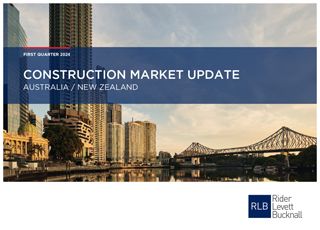According to the Rider Levett Bucknall (RLB) 1st Quarter Oceania Report, forecasts indicate the industry will experience sustained growth because of continued high demand for housing and historically high spending by federal, state and territory governments.
Director Domenic Schiafone commented, “While continuing its contribution of approximately 10% of Australia’s GDP, the construction industry grapples with persistent influences of high escalation, industry solvency, low productivity, and labour shortages. However, the outlook for the construction industry is positive.”
Infrastructure spending now top priority for governments
He added, “Governments across all levels in Australia are prioritising infrastructure spending. This includes projects related to roads, rail, utilities, renewable energy and social infrastructure like schools, hospitals, and recreational facilities. This commitment to infrastructure development is expected to continue to inject significant funds into the industry, creating a steady stream of projects for construction companies.”
The RLB Report noted that construction market escalation forecasts for 2024 indicated a downward movement closer to historic levels, following the highs of 2022.
Adelaide and Townsville are the Australian cities forecast to experience the highest increase in tender prices across 2024 (with a respective estimated of 6.5% and 7% increase).
RLB TENDER PRICE INDEX ANNUAL % UPLIFTS AS AT Q1 2024
| AUSTRALIA | 2022 | 2023 | 2024 f | 2025 f | 2026 f | 2027 f | 2028 f |
|---|---|---|---|---|---|---|---|
| Forecast period | |||||||
| ADELAIDE | 12.5 | 5.1 | 6.5 | 5.0 | 4.5 | 4.0 | 3.5 |
| BRISBANE | 10.5 | 6.0 | 6.0 | 5.1 | 5.1 | 5.1 | 5.1 |
| CANBERRA | 5.0 | 4.5 | 4.0 | 3.5 | 3.0 | 3.0 | 3.0 |
| DARWIN | 8.0 | 5.5 | 4.5 | 4.0 | 4.0 | 4.0 | 4.0 |
| GOLD COAST | 15.5 | 10.5 | 6.0 | 5.0 | 5.0 | 5.0 | 5.0 |
| MELBOURNE | 8.0 | 8.0 | 5.0 | 4.0 | 3.5 | 3.5 | 3.5 |
| PERTH | 9.4 | 5.8 | 5.0 | 4.4 | 4.0 | 3.5 | 3.2 |
| SYDNEY | 6.9 | 6.0 | 4.5 | 3.5 | 3.5 | 3.5 | 3.5 |
| TOWNSVILLE | 12.6 | 8.0 | 7.0 | 6.0 | 5.0 | 4.0 | 4.0 |
Labour shortages in South Australia impacting pricing
According to RLB’s Oceania Report, the South Australian economy continues to operate at near capacity with unemployment at low levels. Throughout 2024, labour shortages and rising wage costs, fuelled by robust industry demand, will persistently drive-up prices.
In Adelaide, market volatility continued in Q1 2024, with labour shortages impacting pricing. However, increased labour costs were partially offset by stabilising material costs. Potential insolvency of minor and major subcontractors remains an economic concern across all trades and market sectors.
Robust pipeline of work in the Northern Territory
Following continued investments in defence and infrastructure upgrades, the Northern Territory boasts a robust pipeline of work. Additionally, the establishment of the Housing Australia Future Fund (HAFF) is set to generate a series of social and affordable rental housing projects across regional NT, further bolstering the region’s development prospects.
A two-speed market emerging in Southeast Queensland
The Southeast Queensland market continues to operate at, or near, capacity. This is being driven by government activity, with major expansion projects in health, education, and corrections. In addition, the Olympic venues and Athlete’s Village are expected to commence soon.
These major government projects are diverting resources from the private sector. As a result, the private sector is facing major project feasibility challenges, particularly in the residential sector. Projects valued at over $80 million in construction value are proving particularly challenging, with a very limited pool of tier one contractors and subcontractors.
Lower tier contractors are subcontractors are providing competitive pricing on some projects to shore up workload in the wake of waning new private sector project commencements.
The Brisbane market remains generally buoyant. However, the private sector faces significant challenges in rendering projects viable due to elevated construction costs. There is no apparent catalyst in sight to curtail these rising costs.
On the Gold Coast, skilled labour shortages are reducing productivity, leading to project delays and increased wage costs. Insolvency risks and associated provisions in construction contracts are increasing project costs and financial uncertainty for the entire construction supply chain. Sub-contractor additional risk pricing by larger, higher-tier subcontractors could lead to inflated costs for construction projects.
Government-funded projects in Melbourne driving activity
Construction activity in Melbourneremains robust, primarily driven by government-funded projects in public sectors such as health, education, rail, roads and infrastructure.
In the private sector, industrial and Build-to-Rent (BTR) projects show strong activity levels, whereas commercial office spaces and large-scale residential projects are more subdued.
Building contractors are facing challenges in securing both skilled and unskilled labour, as they compete with large-scale infrastructure projects and other activities across regional borders.
Pricing escalation a challenge across Western Australia
In Perth, pricing has stabilised for short-duration, low-risk projects. Although, there was still a typically broad range of prices across most trade and head-contractor preliminary costs.
This is particularly evident in regional areas and for complex metropolitan projects. Factors such as labour shortages, high demand, productivity issues, and challenging economic conditions have continued to drive market volatility into the first quarter of 2024.
Residential and commercial sectors in NSW remain subdued
In Sydney, many institutional developers are shifting their focus from commercial projects to the residential and industrial sectors, with build-to-rent, co-living, and student accommodation becoming prominent areas of interest.
Nonetheless, in New South Wales, activities are still predominantly centred around ongoing government-led projects in hospitals, schools, and infrastructure. The residential and commercial sectors remain subdued due to high interest rates and inflation, and oversupply issues, respectively.
Insufficient resources in North Queensland and Townsville
The rollout of significant state government projects in health, defence, and corrections in North Queensland and Townsville is significantly impacting the overall construction market.
The entire industry – from labour and subcontractors to head contractors and consultants—is stretched thin, with insufficient resources to adequately support projects in the region. As a result, construction timeframes are increasing.
Labour costs are escalating above the rate of inflation. Although the rate of increase in construction costs across Townsville is slowing, a considerable rise is still anticipated in 2024 and beyond.
In tender submissions, there are modest improvements in preliminary levels and slightly reduced profit margins. However, these remain significantly higher than pre-COVID levels.
Effective strategies needed for sustained growth
Domenic concluded, “The Australian construction industry is at a pivotal juncture. Effective strategies from all levels of government, contractors, and developers are essential for steering the industry towards a period of sustained growth. By embracing adaptability, innovation, and a commitment to sustainability, the construction industry will build a resilient path forward.”
NEW ZEALAND
According to RLB’s Oceania Report, Auckland remained at the forefront of construction activity across NZ’s regions. The value of construction work increased in Auckland and, to a lesser extent, in Waikato. This contrasts with other regions, such as Wellington and Canterbury, where construction activity contracted.
New construction work in Auckland fuelled by migration
Auckland now accounts for approximately 41% of nationwide construction activity (on a nominal basis). This concentration of new construction work in Auckland is largely driven by the region’s strong population growth, which has been fuelled by migration.
Weak residential construction demand has been broad-based across the regions. The decline has been particularly marked in Auckland, following very strong growth in the region in 2021 and 2022. Annual Auckland dwelling consent issuance fell to just under 15,500 for the year to December 2023. This represents a 27% decrease compared to the same time in 2022.
Higher interest rates forecast to dampen construction demand
RLB anticipates that higher interest rates and restricted access to finance will continue to suppress residential construction demand over the next 12 months.
However, strong migration-led population growth will support residential construction demand from 2025. This upturn will likely be spurred by a recovery in house prices, encouraging property developers to introduce new housing to the market. Other construction indicators also point to a weak near-term pipeline of construction activity.
RLB TENDER PRICE INDEX ANNUAL % UPLIFTS AS AT Q1 2024
| NEW ZEALAND | 2022 | 2023 | 2024 f | 2025 f | 2026 f | 2027 f | 2028 f |
|---|---|---|---|---|---|---|---|
| Forecast period | |||||||
| AUCKLAND | 12.0 | 5.5 | 2.5 | 2.0 | 3.5 | 4.0 | 4.0 |
| CHRISTCHURCH | 9.0 | 5.0 | 4.0 | 3.0 | 2.5 | 2.5 | 2.5 |
| WELLINGTON | 9.0 | 5.0 | 4.0 | 3.0 | 3.0 | 3.0 | 2.5 |
Decline in construction activity in Auckland
Broader economic conditions are affecting construction demand in the Auckland region, leading to a noticeable decline in construction activity.
Despite record levels of immigration, the high interest rate environment has significantly curtailed both residential and non-residential development. Additionally, the new government’s fiscal restraint is expected to make 2024 and 2025 challenging years for the construction industry.
Decrease in residential construction in Christchurch
In Christchurch, trade pricing is stabilising due to heightened competition, which could lead to more predictable project costs. Residential construction activity has slowed in recent months, indicating a potential downturn in this sector.
A significant ongoing school program has been paused under the new government, delaying educational infrastructure developments. Variations in trade pricing for large and complex projects reflect differing risk assessments and the clarity of future workload, affecting project budgeting and planning.
While large pipelines of infrastructure work are expected nationally in the coming years, there is uncertainty about the scale of these projects in various regions, which may lead to uneven development and investment.
Wellington experiencing strong demand with major challenges
Wellington’s construction market presents a complex picture, with positive trends offset by several challenges.
The city is experiencing significant demand for construction services, fuelled by infrastructure projects and residential development, such as the regeneration of Te Aro.
However, labour shortages persist as a major obstacle, with the industry facing difficulties in finding and retaining skilled workers – a problem that is not unique to Wellington but prevalent nationwide.
In addition, supply chain issues and rising labour costs are placing pressure on builders and developers, which could lead to project delays and increased costs.
Photo: RLB provided quantity surveying services on 443 Queen St, Brisbane, a Cbus Property residential development. Photo credit: Cieran Murphy.
FURTHER INFORMATION:



